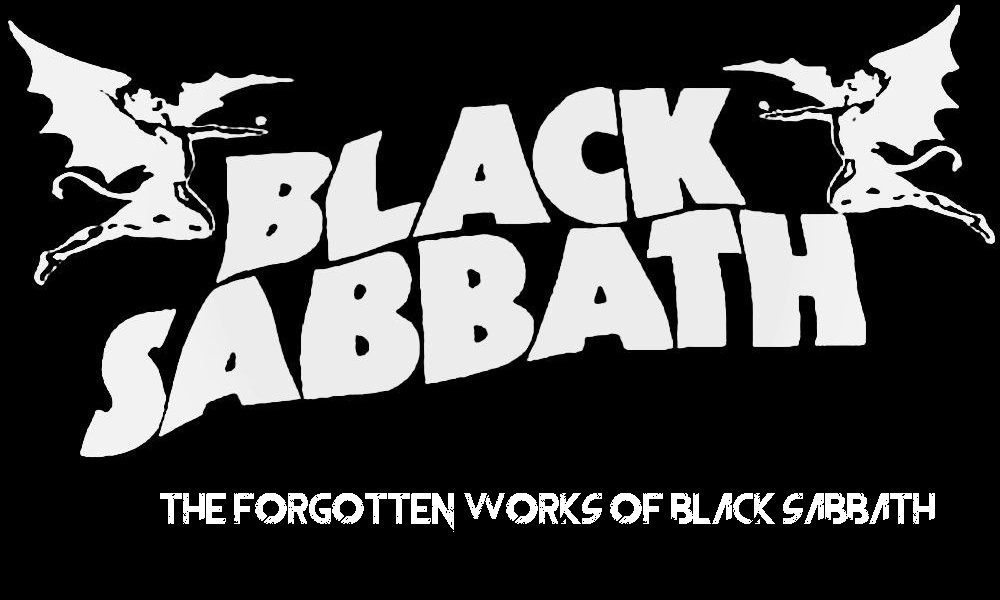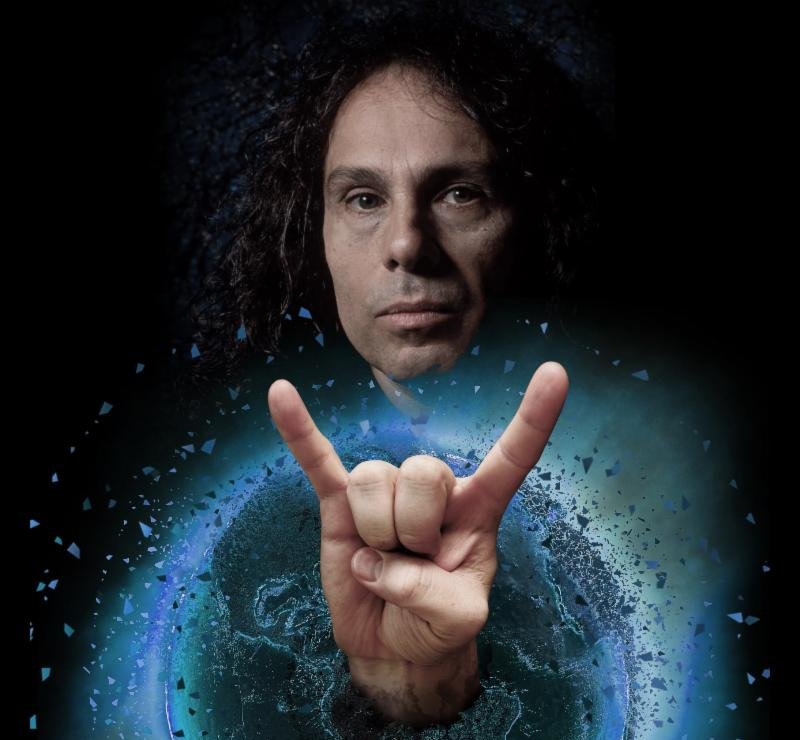
Black Sabbath recorded, toured, and worked for decades. Most fans are familiar with the first ten albums consisting of the first eight Ozzy Osbourne records and the first two Ronnie James Dio releases. Besides the landmark studio albums that came later, many semi-lost and neglected partnerships and recordings sit off the grid. There are a lot of rich and interesting paths to explore in some of these side avenues, roundabouts, and cul-de-sacs that diverge from the main streets of the standard studio releases. None of these will probably overtake your favorite Sabbath record, but if you are enough of a Sabbath fan to have a favorite Sabbath record, the following side trips will interest you. Some are paved streets branching directly off from a big city road and others are faint impressions in the country dirt.
Our first detour is singer Ray Gillen known best for his work with Badlands. Seventh Star (1986) featured Glen Hughes on vocals. After only a handful of dates into the tour for the record, Hughes got into a fight with Black Sabbath’s production manager. Internal conflicts, substance abuse, broken bones in Hughes’ nose, along with reports that Hughes’ physical condition was compromised for touring led to Hughes’ departure, Gillen’s recruitment, and Gillen’s subsequent completion of the tour. A live show from June 2, 1986 with Gillen was released as the second disc on the 2010 deluxe edition of Seventh Star. Sabbath’s next album was The Eternal Idol (1987), which most of us know as vocalist Tony Martin’s Sabbath debut, which it is, except for when it wasn’t. Originally, it was recorded with Gillen and was intended to be the second Sabbath offering with him, but he but left before its release. The second disc of the 2010 deluxe edition of The Eternal Idol has eight of the tracks from those recording sessions. If you put the bonus discs of Seventh Star and The Eternal Idol together, you can make an alternate version of The Eternal Idol with a live show, both featuring Gillen.
Our second side street features the aforementioned Hughes. Billed as Iommi with Glen Hughes, The 1996 DEP Sessions (2004) showcases a collaboration between vocalist Hughes and guitarist Tony Iommi in 1996. Originally, it was a bootleg called Eighth Star. The two released another record together in 2005, Fused. Whatever happened back in the mid and late Eighties, Iommi and Hughes seemed to have sat down for tea and worked through it. While it might seem like a stretch to count work with only Hughes and Iommi as Black Sabbath, there are a number of other Sabbath records such as The Eternal Idol, Headless Cross (1989), Tyr (1990), and Forbidden (1995) on which Iommi is the sole founding member playing. By the way, Iommi originally envisioned Seventh Star as a solo album, but Black Sabbath’s label wanted it released under the Sabbath name even though Iommi was the only original member playing on it. They reached a sort of compromise and the cover reads, “Black Sabbath Featuring Tony Iommi. So while it was the first Sabbath album with only Iommi from the original lineup, it would not be the last.
Our third expedition into the back alleys of Black Sabbath history involves a quite unexpected name. Black Sabbath have had a number of players and singers in the band. One of the more incredible possibilities was pop balladeer Michael Bolton. After Dio’s first departure, Black Sabbath once again set out to find a new frontman. A story circulates that Bolton tried out for the lead singer position. Bolton denies that ever happened. In 2014 he said, “That rumor about me auditioning for Black Sabbath was only a rumor. I don’t know how on earth it started.” That begs the question of just how it might have gotten started. Bolton had an early hard rock band called Blackjack, the name of which shares obvious similarities with Black Sabbath. One assumes they must have had a heavier sound than what Bolton would later become known for since Blackjack opened up for Ozzy Osbourne. Sabbath had and continued to develop a history of finding rock singers with a hard blues sort of vocal approach such as Glen Hughes, Ian Gillan, and Ray Gillen. Robert Plant and David Coverdale are other singers in that same spectrum whose names came up for potential recruitment. It’s not impossible to see Bolton in this context, especially in his younger years when he was more rock-oriented. The singer they did end up with, Tony Martin, did carry some resemblance to Bolton in both looks and vocals at the time (Martin might not mind his bank account having a strong similarity to Bolton’s, either). When we put it all together, the story sounds like some urban myth concocted by odd coincidences and superficial parallels.

However, Iommi verified the story of Bolton’s audition in his Iron Man: My Journey Through Heaven and Hell with Black Sabbath (2012). He recounts that during Black Sabbath’s search for yet another vocalist, they heard a tape “from Michael Bolton.” Iommi remembers that “We had Michael come in and we had him sing ‘Heaven and Hell,’ ‘War Pigs,’ and ‘Neon Knights.’ He was quite good, but he wasn’t exactly what we were looking for then.” While the thought of Bolton singing “Children of the Grave” or “War Pigs” may make Sabbath fans cringe, no one knows what the combination might have yielded. For better or worse, no recorded evidence has surfaced. As a brief side note there is, however, a bootleg floating around of early Seventh Star material with the vocals of Jeff Fenholt who went on to become a televangelist, which makes the thought of Bolton in Sabbath seem not nearly as strange.
Collaborations have always been a tantalizing occurrence in hard rock and metal history. Some make you wonder what would have happened if there had been more work (e.g., David Bowie and Queen). Others look good on paper but flopped in the flesh for various reasons (e.g., Jim Morrison and Jimi Hendrix).
Here are two such collaborations with Black Sabbath that provide our fourth and fifth alternate routes.
In late 1973 while working in the studio, Black Sabbath supposedly had a legendary jam with John Bonham, Robert Plant, and John Paul Jones of Led Zeppelin (Jimmy Page was elsewhere). Unlike the possible Bolton collaboration, all involved parties agree that it happened.
Plant singing “Paranoid” at the top of his lungs? Ozzy giving “Dazed and Confused” a run-through? John Paul Jones adding even more sounds and layers to “Planet Caravan?” Everyone jamming out on “Whole Lotta Love?” The mind salivates. Specific recollections of what was played are mostly lost to time. Iommi says that “Supernaut” was attempted in some form, and he remembers them all “just jamming, making stuff up.” Sabbath drummer Bill Ward said the session was not recorded, but Iommi said it was. So far, however, he has been unable to locate the tapes, which one hopes turn up before any missing Bolton recordings.
Unlike the Led Sabbath / Black Zeppelin session, Rob Halford’s work with Sabbath was both taped and filmed. Black Sabbath were set to open for Ozzy on November 14 and 15 of 1992 in Costa Mesa, California. However, Dio, who was singing for Sabbath at the time, refused. Sabbath turned to Halford who had recently left Judas Priest. The audio and video are not the best, but the performance is not bad, especially considering the lack of time to prepare. Halford said, “We had one little practice in Phoenix, in a tiny rehearsal room. We ran through everything once, and the show was the next day. We had no time to think.” By August 26, 2004 Ozzy had rejoined Sabbath and Halford was back with Priest. Both bands were playing Ozzfest. Suffering from bronchitis, Ozzy was unable to sing. With just a few hours of notice, Halford watched the previous night’s show “on the tour bus, from the hotel to the venue, singing acapella with Ozzy.” He was able to run through it only once because he still had his own set with Priest to perform. Again, the results are not perfect—although the recording seems better—but not bad either. Given the choice of having this on tape or the Bolton audition, I’ll take the Halford shows. With three shows under his studded belt, Halford performed almost as many times with Black Sabbath as Hughes did.
Ozzy and Dio are always the names we most associate with Sabbath. Yet with five studio albums, Martin finishes just behind Ozzy with the most Sabbath studio albums by a vocalist, and he provides our sixth highway. In 1995, Sabbath released Cross Purposes Live, a video and audio complement to 1994’s Cross Purposes. Many fans consider Cross Purposes to be one of the lower points of the Sabbath catalog as well as the Martin era and there was no single or video release to promote Cross Purposes Live, so it’s little wonder that it received so little notice. That’s a real shame as it’s the only live document of Black Sabbath with Martin. The show sounds good and the set list is balanced despite skewing towards the Ozzy material as Sabbath set lists must do. Of its seventeen tracks only three are from Cross Purposes, about half come from the Ozzy years, and the rest cover all three Dio albums and three of the four records Martin had recorded at that point with Sabbath. It has never been reissued (Incidentally, if you are looking for more material from Martin, he released two solo albums).

The seventh and eight byways are the byproducts of bonus editions and the practice of tacking on new studio tracks onto various types of compilations such as live albums, box sets, and greatest hits collections.
Dio, Iommi, bassist Geezer Butler, and drummer Vinny Appice made two records together as Black Sabbath: Mob Rules and Dehumanizer. In 2009, the same members regrouped and called themselves Heaven & Hell, which is the name of one of the Dio-led Black Sabbath albums (somewhat since Ward and not Appice played drums on Heaven and Hell). Iommi said, “It’s all Dio stuff.” They released one studio album, The Devil You Know in 2009 before Dio’s unfortunate passing in 2010 (there are two lives albums also). While The Devil You Know is not obscure, it is not officially a part of the Sabbath discography, despite the name of the band being the only significant difference. If you want to deepen it, you can add three new songs recorded by the Heaven & Hell lineup for the 2007 compilation Black Sabbath: The Dio Years: “The Devil Cried,” “Shadow of the Wind,” and “Ear in the Wall.”
Reunion (1998) is a live album of the original Sabbath members. They made and added two new studio recordings—their first with the original lineup since 1979. Those tracks are “Psycho Man” and “Selling My Soul.” 13 (2013), minus Ward, is the final Sabbath album. Various configurations came out. You can assemble a total of four bonus tracks from versions of the 13 release: “Methademic,” “Peace of Mind,” “Pariah,” and “Naïveté in Black.” Black Sabbath only released one EP, The End (2016). The last four songs are live songs from 2013-2014. The first four songs are leftover tracks from the 13 sessions: “Season of the Dead,” “Cry All Night,” “Take Me Home,” and “Isolated Man.” Put that all together and you’ve got a ten-track album from the majority of the classic lineup. It would be cool and convenient if the various labels this material is spread over would come together and coordinate a single album release collecting all ten songs—call it Spirits or something else evoking the loose, floating phantasms that these tracks are.
New material continues surfacing as bands, band members, and labels clear out the vaults, run across tapes, and decide to put out items they’ve been sitting on for years and sometime decades. Iommi previously said that he plans to reissue the rest of the Martin albums. Perhaps there will be more bonus material to further map out the Black Sabbath legacy. For example, accounts/rumors persist of an alternate recorded version of Dehumanizer with Martin on vocals. Who knows what we will find next?
When it comes to classic rock, the past just keeps getting bigger.



